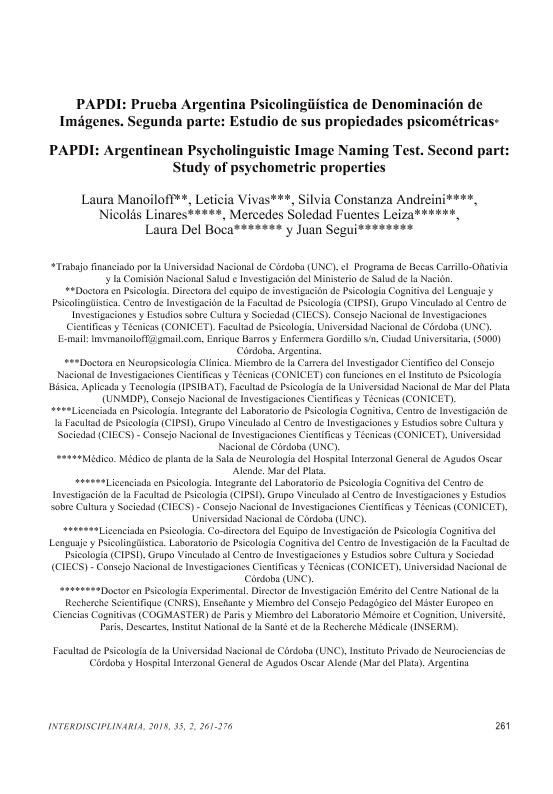Artículo
En el presente trabajo se detallan los análisisrealizados con el fin de estudiar las propiedadespsicométricas la Prueba Argentina Psicolingüística de Denominación de Imágenes(PAPDI). La misma cuenta con dos cualidadesque representan un valor agregado frente a laspruebas actualmente disponibles en nuestro país:a) los estímulos fueron seleccionados controlando las variables que afectan las etapas deanálisis visual y de representación conceptual dela imagen del objeto y se manipularon las variables que afectan la selección y recuperaciónde la etiqueta léxica, en base a valores normativos de población argentina; y b) las claves semánticas se elaboraron de acuerdo con normasde producción de atributos semánticos tambiénrecolectadas en nuestro país. En este trabajo seanalizaron las propiedades psicométricas mediante el estudio de pacientes con demencia tipoAlzheimer, con lesiones cerebrales focales yparticipantes sin patología neurológica. Se buscaron evidencias de validez de criterio medianteel análisis de grupos contrastados y la correlación con el test de Boston. A su vez, se estudióla confiabilidad de las puntuaciones por dos métodos: consistencia interna y test-retest. Tambiénse analizó la capacidad de discriminación entrepacientes con y sin anomia mediante curvasROC. Se estudiaron además los efectos de lasvariables manipuladas, se realizó un análisiscualitativo de los errores y se examinó el desempeño en función del uso de las claves. Los resultados de los análisis aportan evidencia de quepresenta cualidades psicométricas sumamenteaceptables para su uso en nuestra población. In the current paper we present the psychometric analysis of the Argentinean Psycholinguistic Image Naming Test (PAPDI). This test has two characteristics that makes it different 262 Vivas, Andreini, Linares, Fuentes Leiza, Del Boca y Segui from those currently available in our country: a) the stimuli has been chosen and ordered controlling certain psycholinguistic variables proven to have influence on this task, such as Visual Complexity, Image Agreement, Image Variability, Familiarity, Name Agreement, Age of Acquisition and Frequency of Use, following Argentinean normative data base; and b) semantic cues were elaborated according to semantic feature production norms also from Argentina. We present here the psychometric analysis of its properties. There were analyzed through the study of patients with Alzheimer Disease (n = 25) and focal brain lesions (n = 27) and healthy participants (n = 125). On the first place, in order to study criteria validity a group comparison analysis was carried out. On the one hand Alzheimer Disease patients were compared with healthy participants. On the other hand, two focal brain damaged patients were compared: with and without aphasia. Convergent validity was also stu- died through the correlation with Boston naming test. In the third place, scores reliability was studied through two methods: internal consistency analysis, for Alzheimer, focal and healthy groups, and test-retest for focal brain damage group. Forth, it was analyzed the capacity to discriminate between patient with and without aphasia through ROC curves analysis. The respective sensitivity and specificity values to detect anomia were established. Fifth, the demographic variables ́ influence was analyzed through a regression analysis. Moreover, there were analyzed the effects of two psycholinguistic variables that were taken into account to order the images but were not normalized: Lexical Frequency and Age of Acquisition. Finally, type of errors and response to cues were studied for focal brain damaged patients. The results indicated that the PAPDI presents acceptable psychometric properties to be used as a tool in neuropsychological assessment. It showed evidence of internal and external validity and it was observed scores reliability through internal consistency and test-retest. A suggested cutting point was established to detect anomia. Furthermore a main influence of educational level was reported. There were also detected effects of Lexical Frequency and Age of Acquisition which were observed for Alzheimer and aphasic patients groups. Moreover it was illustrated the
response profile analysis for aphasic and non aphasic focal brain damaged patients regarding a proposed taxonomy of error types. It was also studied the response to semantic and phonological cues and it was observed that both contributed to improve patients ́ performance.
Prueba Argentina Psicolingüística de Denominación de Imágenes (PAPDI). Parte 2. Estudio de sus propiedades psicométricas
Título:
Argentinean Psycholinguistic Image Naming Test (PAPDI). Part 2. Study of the psychometric properties
Manoiloff, Laura Maria Victoria ; Vivas, Leticia Yanina
; Vivas, Leticia Yanina ; Andreini, C.; Linares, N.; Fuentes Leiza, Mercedes Soledad; Del Boca, Laura; Segui, Juan
; Andreini, C.; Linares, N.; Fuentes Leiza, Mercedes Soledad; Del Boca, Laura; Segui, Juan
 ; Vivas, Leticia Yanina
; Vivas, Leticia Yanina ; Andreini, C.; Linares, N.; Fuentes Leiza, Mercedes Soledad; Del Boca, Laura; Segui, Juan
; Andreini, C.; Linares, N.; Fuentes Leiza, Mercedes Soledad; Del Boca, Laura; Segui, Juan
Fecha de publicación:
12/2018
Editorial:
Centro Interamericano de Investigaciones Psicológicas y Ciencias Afines (CIIPCA)
Revista:
Interdisciplinaria
ISSN:
1668-7027
Idioma:
Español
Tipo de recurso:
Artículo publicado
Clasificación temática:
Resumen
Archivos asociados
Licencia
Identificadores
Colecciones
Articulos(IPSIBAT)
Articulos de INSTITUTO DE PSICOLOGIA BASICA, APLICADA Y TECNOLOGIA
Articulos de INSTITUTO DE PSICOLOGIA BASICA, APLICADA Y TECNOLOGIA
Citación
Manoiloff, Laura Maria Victoria; Vivas, Leticia Yanina; Andreini, C.; Linares, N.; Fuentes Leiza, Mercedes Soledad; et al.; Prueba Argentina Psicolingüística de Denominación de Imágenes (PAPDI). Parte 2. Estudio de sus propiedades psicométricas; Centro Interamericano de Investigaciones Psicológicas y Ciencias Afines (CIIPCA); Interdisciplinaria; 35; 2; 12-2018; 261-276
Compartir



